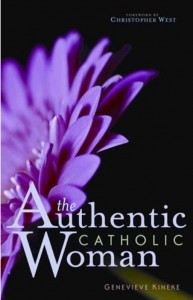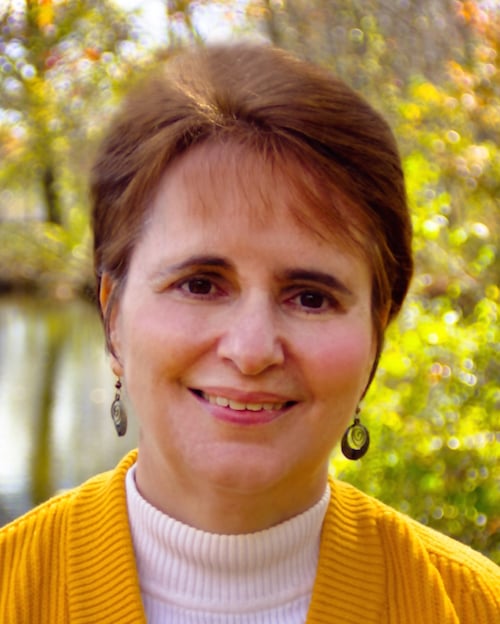Editor's Note: Today, we begin sharing a wonderful ten part series by my dear friend and wonderful Catholic musician Susan Bailey. Tune each Sunday for the newest installment in Susan's sharings. LMH
 Recently I gave a talk for a half day retreat in Henniker, NH. The topic was “What does it take to become a beautiful Godly woman?” I researched the topic by reading 2 books at once: The Authentic Catholic Woman by Genevieve Kineke and The Prayer of Mary by Deacon Keith Fournier. Fournier’s book in particular has had a transforming affect on my life as his book gently but firmly led me to the beginning of living a life of surrender to God. I am just starting to do this but already I can feel the difference. Fournier used Mary as the model and my love for her has grown exponentially as a result. Mary was the most beautiful woman this world has ever known and I hope can hope to achieve even a glimmer of her beauty as I learn to follow her path to Jesus.
Recently I gave a talk for a half day retreat in Henniker, NH. The topic was “What does it take to become a beautiful Godly woman?” I researched the topic by reading 2 books at once: The Authentic Catholic Woman by Genevieve Kineke and The Prayer of Mary by Deacon Keith Fournier. Fournier’s book in particular has had a transforming affect on my life as his book gently but firmly led me to the beginning of living a life of surrender to God. I am just starting to do this but already I can feel the difference. Fournier used Mary as the model and my love for her has grown exponentially as a result. Mary was the most beautiful woman this world has ever known and I hope can hope to achieve even a glimmer of her beauty as I learn to follow her path to Jesus.
It seems obvious to me that Mary should be the first focus as an example of a beautiful Godly woman and I’m seeing a lot of parallels in Kineke’s thesis that the Church as the Bride of Christ is the ultimate example that universally applies to all women: past, present and future, and the fact that Mary is the perfect example of the Church as the Bride.
 Christopher West, known for his work the Pope John Paul II’s Theology of the Body wrote a wonderful preface to this book that contends two things:
Christopher West, known for his work the Pope John Paul II’s Theology of the Body wrote a wonderful preface to this book that contends two things:
- To be human is to receive God’s love, conceive God’s love, and carry it forth to others – this is the Bride of Christ, the Church, and why woman is the model of the human race (see how Mary is the perfect example?)
- Because of original sin and sin in the world, the view of God has been grossly distorted from that of loving and merciful Father to jealous and dominating tyrant.
Mary, to me, is the perfect example of how the creature and the Creator were meant to live together.
However, because of this distorted view of God (and of masculinity) as that of power and dominance over others, woman’s greatest blessing of receptivity to love and life is seen as a curse (Preface, The Authentic Catholic Woman, pg. IX). Her blessing places her under the domination of others in the eyes of the world.
I found as I read that I was flooded with thoughts of all the reading I’ve done lately about 19th century women in New England and how they were the property of their husbands, with no rights of their own. A woman in the 19th century (and obviously throughout history) lost all autonomy when she married. In society she had no right to vote or own property, and in her own personal life, had no voice regarding her own self and her body. This in a supposedly religious society. Even in the inner circle of the religious, the image of God and how He relates to human beings was so distorted. How else could men believe they could own their wives as property? And is it any wonder that women fought back?
I have felt contempt for current day feminists for a long while but now I feel compassion. While I see the error of their methods and the tragic outcome of their actions (most especially contraception and abortion, equaling a rejection of receptivity to new life), I do understand why they feel so passionately about their cause. Kineke and West both point out that feminists today, rather than embracing the Godly image of woman, toss it all in favor of obtaining power by becoming more masculine (Ibid). In other words, if one has no understanding of God as loving Father, one will not understand the unique role of women in His plan. Men will continue to dominate and women will continue to fight back. Mary will never be understood as the perfect role model.
Copyright 2011 Susan Bailey
About the Author

Susan Bailey
Susan Bailey is the author of River of Grace: Creative Passages Through Difficult Times (Ave Maria Press), and Louisa May Alcott: Illuminated by The Message (ACTA Publications), part of their Literary Portals to Prayer series. Along with her blogs Be as One and Louisa May Alcott is My Passion, Susan writes for the Diocese of Worcester newspaper, The Catholic Free Press.


.png?width=1806&height=731&name=CatholicMom_hcfm_logo1_pos_871c_2728c%20(002).png)
Comments